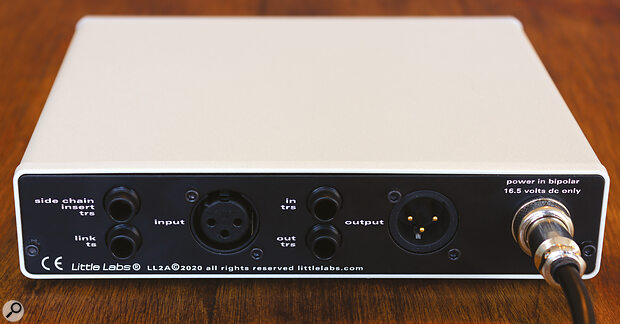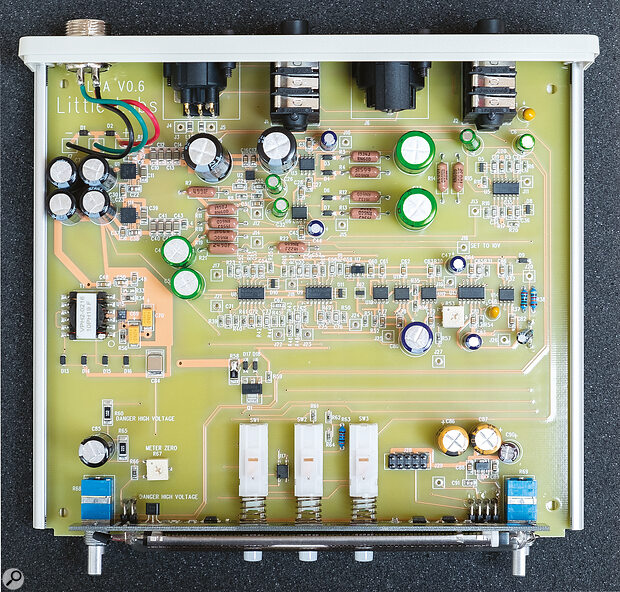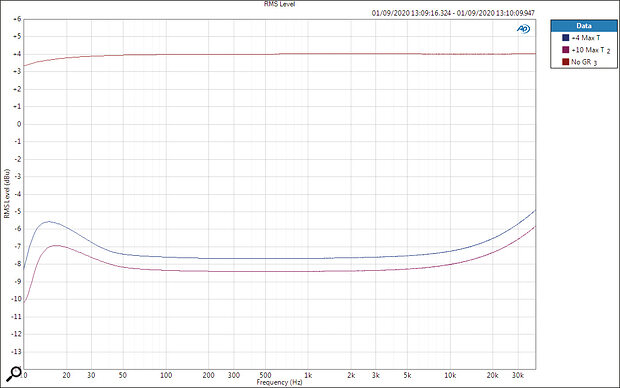Ever wondered what a ‘four‑quadrant analogue multiplier compressor’ might sound like? Neither had we — but it turns out to be something a bit special!
Californian manufacturers Little Labs have acquired a great reputation for their range of elegantly, and often unusually, designed products which address all manner of everyday studio requirements. The latest addition to their range is a deceptively simple compressor‑limiter called the LL2A. Before I move on I should state, for the benefit of those with dyslexic tendencies, that there is no direct relationship between this and the famous UREI Teletronix LA‑2A Levelling Amp! In fact, from a technology point of view, this Little Labs design is a wholly original product for which designer Jonathan Little has adopted an unusual approach and used some even more unusual technology, aided by the analogue modelling expertise of Anamod’s co‑founder Dave Amels — the ‘A’ in the product name is a reference to Amels’ contributions.
Overview
The LL2A unit is a half‑rack width, 1U‑high device, and an optional panel is available for those wishing to rack two units together. Fitting the rack panel is straightforward, and I was impressed to find the hex keys required to remove the knobs and front panel are provided with every LL2A. Mains power is provided by an external universal switch‑mode (line‑lump) power supply made by InPhase Engineering. This is built into a nice metal case and delivers ±16V DC from any mains supply between 100‑240 V AC. Unfortunately, the review model did not carry the CE marking necessary for sale in the UK and Europe, although I’m sure that was more of an administrative oversight on the review model than a real problem. The PSU output cable is terminated in a Vellman CUF4, four‑pin, screw‑locking power connector, as is used on many other Little Labs products.
The audio connections are straightforward, although there is a very unusual option which I’ll return to later. The electronically balanced input and output are both available on parallel‑wired XLR and TRS connectors, so either format can be used. For stereo operation with a second LL2A, the side‑chains of both units can be coupled by patching a standard unbalanced instrument cable with TS plugs into their Link sockets. The front panel controls have to be set the same on both compressors, of course, and whichever compressor calls for the most gain reduction wins.
Another TRS socket is labelled ‘Side‑Chain Insert’. This is actually a misnomer, as it’s a balanced side‑chain input which overrides the normal side‑chain signal path derived from the audio input. A balanced line‑level signal connected to this side‑chain input can be used to introduce gain‑reduction, or ‘ducking’. This is useful for allowing a bass guitar to be ducked by a kick drum, for example, or for guitars or reverb returns to be ducked to leave space for the vocals.
Alternatively, this side‑chain input can also be used to reduce the compressor’s sensitivity to bass frequencies. If the compressor’s main input signal is also routed into a high‑pass filter, the output from the filter can be injected back into the side‑chain socket, thereby reducing the compressor’s sensitivity to the low‑end of the mix. It’s a technique which is very helpful when performing bus compression, for example. This approach might seem a faff on some compressors, but here the provision of parallel‑wired XLR and TRS sockets for the input makes it very convenient to obtain the necessary signal split.
 The LL2A uses an external PSU, which fastens firmly to the main unit via a screw connector.
The LL2A uses an external PSU, which fastens firmly to the main unit via a screw connector.
Controls
When it comes to setting up the LL2A, there are just two knobs: a Threshold control and the Output (make‑up gain) level. Both are scaled in an arbitrary 0‑10. There are also three buttons, which illuminate green when pressed, and these engage the stereo‑link mode (if a second unit is connected), switch the meter display between the output level and gain‑reduction, and enable a bypass, effectively disabling the compressor side‑chain. The Output control ranges from unity gain to +18dB of boost, while the Threshold control determines the amount of compression. At its maximum setting (10), compression starts when the signal exceeds about ‑12dBu at the main input, or ‑15dBu at the side‑chain input.
 A set of traces showing the compression curves for all 10 numbered settings of the Threshold control. Settings 0, 1 and 2 all display as 1:1 since their threshold is well above +24dBu, and settings 9/10 are almost inseparable.
A set of traces showing the compression curves for all 10 numbered settings of the Threshold control. Settings 0, 1 and 2 all display as 1:1 since their threshold is well above +24dBu, and settings 9/10 are almost inseparable.
As with other so‑called ‘two‑knob’ compressors, setting this unit up is simply a case of increasing (lowering) the Threshold to achieve the desired amount of ‘squash’, and then adjusting the Output control to set the desired output level. By toggling the bypass button it’s easy to quickly match the peak level of the compressed signal to that of the input signal, making it easier to judge the increase in perceived loudness.
The attack and release times at first appear to be fixed, with a very fast 400µs attack time and 0.9s release. Little Labs suggests these settings were inspired by the classic Fairchild 670 compressor and were chosen as optimal for vocal and bus compression. Such values, which are arguably closer to a typical limiter’s time constants, are certainly fast enough to cause audible transient or waveshape distortion on some instruments, particularly bass guitars. However, if the Link button is pressed without a second device being connected, the time constants are magically extended to around a 2.4ms attack and 4.9s release. That neatly avoids any distortion problems, making the LL2A very effective for compressing bass instruments too.
The compression ratio is also preset, at about 7:1, which is again nearing that of a limiter. That said, the compression curve has a soft knee, so the ratio smoothly increases as the input signal gets louder (or the threshold is lowered).
Instead of a ‘traditional’ LED meter or miniature VU, Little Labs have pushed the boat out and installed a lovely high‑voltage Nixie tube, apparently obtained from a NOS supply in the Ukraine. This can be switched to show either the output level or the amount of gain‑reduction, as mentioned above, and it looks absolutely fabulous! The metering has a pseudo VU characteristic with a scale spanning ‑30 to +6 dB, and the 0dB mark is aligned to +4dBu. Although the meter peaks out at +10dBu, the maximum output level from the LL2A is actually a very healthy +28dBu. And while I’m mentioning numbers, the input impedance is 20kΩ and the output impedance is under 0.5Ω! Yes, you read that right: the LL2A uses the same output driver arrangement as the company’s Monotor headphone amp (a very low‑impedance, high‑current design), so you could plug headphones into the output if you really wanted to!
Technology
At its core every compressor requires a gain reducing element; some way of attenuating the signal level as determined by the side‑chain’s control signal. Some devices use light‑sensitive resistors (or semi‑conductors), some use FETs, some use valves, or VCA’s, or diode rings, or even analogue pulse‑width modulation! However, the LL2A uses an approach that I’ve not previously encountered in this application. Here, the gain‑reduction element is an analogue signal processor called a ‘four‑quadrant analogue multiplier’. As that term suggests, this active device performs defined mathematical functions on signal voltages, such as multiplication, division, squaring and square‑roots, and it can also be used for various forms of signal modulation too — all entirely within the analogue domain.
In essence, the ‘multiplier’ has two inputs which, in this case, accept an audio signal and a control signal. The ‘four quadrant’ aspect just means that it works with all four possible combinations of signal polarity at the two inputs, which is an important feature when dealing with bipolar audio signals. (This aspect is specified because there are ‘two‑quadrant’ multipliers, as well.) So, to introduce 6dB of gain reduction the audio signal is multiplied by 0.5 (or divided by 2), and greater or lesser amounts of attenuation are implemented by changing the value of the control signal accordingly.
Of course, the practical implementation of a system like this is rather more complicated than this simple overview, and most of that complexity is in the side‑chain electronics. However, the wanted audio signal only passes through the analogue multiplier and the output driver, and this minimalism is claimed to bestow the unit with a very open and clear sound quality.
 For those who like to have a peep inside these things!
For those who like to have a peep inside these things!
For anyone interested in the technology, the particular four‑quadrant analogue multipliers used here are Analogue Devices’ AD633s, and I counted five of them altogether, although I believe some are serving in the side‑chain as the maths involved in generating the required multiplier control signal is quite involved. The LL2A’s internal construction is to a very high standard, with good‑quality SMD components on a single PCB.
Differential Circuitry
The unusual gain‑reduction technology isn’t the only quirky aspect of the LL2A. Most modern devices convert the balanced audio input into an unbalanced signal for internal processing, and then regenerate a balanced signal for the output. In this product, though, there is no balanced‑unbalanced signal conversion at all: the signal path circuitry is completely ‘differential’ throughout.
 Frequency response measurements made with an Audio Precision test system, comparing the responses without gain‑reduction (top trace), and with different amounts of gain‑reduction (bottom two traces). This reveals a tendency towards a ‘smiley curve’, with gentle boosts at very low and high frequencies.
Frequency response measurements made with an Audio Precision test system, comparing the responses without gain‑reduction (top trace), and with different amounts of gain‑reduction (bottom two traces). This reveals a tendency towards a ‘smiley curve’, with gentle boosts at very low and high frequencies.
This is a design technique that was often employed in vintage valve compressors, and what this configuration means is that the signal path circuitry is effectively ‘doubled up’, with one set handling just the ‘hot’ side of the balanced input, and the other set separately but identically handling the ‘cold’ side. This approach brings some technical and practical advantages, albeit at the expense of slightly more signal path electronics (although only one more multiplier, in this case, since the cold‑side output driver would be needed in a conventional arrangement).
One technical advantage of this configuration is, potentially, lower distortion, since some distortion products effectively become ‘common‑mode’ and cancel out when they reach the next balanced input device. And the practical advantage? Well, as the two sides of the circuitry have their own gain‑reduction elements, it’s possible to use a single LL2A to process an unbalanced stereo source, instead of a balanced mono one! And just in case you were wondering, although it’s intended to work with conventional symmetrical balanced signals, the differential arrangement in the LL2A still works perfectly well with impedance‑balanced sources (where the cold‑side carries no signal at all). However, any distortion‑cancelling benefits will be sacrificed, and the output will effectively also be impedance‑balanced too.
With the Threshold control set anywhere between 0 and 2 there is no compression for any input signal level up to +24dBu, which seems a bit of a waste of the control’s range. But a setting of 3 introduces compression for inputs over +16dBu for some peak limiting control. Advancing the Threshold knob further lowers the onset of compression by roughly 5dB for each number on the dial, up to 7. Beyond that point the compression onset reduces by a further 2.5dB at 8 and another 2.5dB at 9, but there’s virtually no difference between 9 and 10, which both introduce the gain‑reduction for signals over about ‑12dBu. Taken as a whole, though, that’s a wide and very usable range, covering everything from gentle peak limiting down to heavy‑duty squashing for typical instrument and mix signals. The external side‑chain input is slightly more sensitive, with the compression starting with an external signal of around ‑15dBu when the Threshold control is at maximum.
The frequency response with no gain‑reduction applied is flat down to 10Hz (‑0.5dB), but when gain‑reduction is applied the response acquires a small ‘smiley’ curve. There’s a small LF boost of around 1.5dB centred at about 15Hz, and an HF rise of around 3dB centred at about 50kHz. Although obviously very subtle, this would explain my perception of slightly more air and a touch more LF weight on some material, especially when used for bus compression.
Total Harmonic Distortion (THD) with no gain‑reduction measured 0.013 percent, increasing progressively as gain reduction is introduced to a maximum of around 0.4 percent. The LL2A’s signal‑to‑noise ratio measured 79dBu (A‑weighted, ref +4dBu, no gain‑reduction), which is not as good as I had expected, but is nonetheless perfectly workable for most applications.
As the two sides of the circuitry have their own gain‑reduction elements, it’s possible to use a single LL2A to process an unbalanced stereo source.
In Use
I tried the LL2A on a wide range of live and pre‑recorded solo instruments, including acoustic and electric guitars, brass, piano, spoken and singing voices, and full mixes (both as balanced mono and unbalanced stereo sources). As I only had the one unit for review, I was unable to test the stereo Link facility, but the side‑chain input function works very well, both for ducking effects and to facilitate external side‑chain EQ.
In all cases I found that this compressor‑limiter proved impressively transparent, and highly effective, even with large amounts of gain reduction. It proved itself particularly impressive on vocals, though, both male and female, and it also tidied up strummed acoustic guitar parts very nicely, without any pumping side‑effects. One of the major strengths of the LL2A is the ease and speed of finding the optimal control settings: squash, level, next — it really is as fast as that!
While the LL2A is not an attempt to emulate the LA‑2A, I think it’s still fair to say that it shares some of the latter device’s desirable sonic characteristics, and it is certainly equally effective when it comes to reigning in vocal dynamics. That said, the fast preset time constants did cause a couple of audible issues, once with a transient distortion on a piano track, and also with some envelope‑following distortion on various solo bass tracks. Thankfully, the ‘slow’ (Link) mode I mentioned earlier proved an effective solution, especially for the bass sources.
Overall, I was extremely impressed with the LL2A which, although intentionally restricted in its controls and settings, is very effective at controlling the dynamics of a wide range of material without drawing attention to itself. The Nixie gain‑reduction meter is a lovely feature, and the fully balanced circuit configuration makes the unit unusually versatile. So if you’re in the market for a new compressor/limiter, I’d recommend the LL2A as an addition to your shortlist.
The Stereo Mono Compressor?
The unusual fully differential circuitry of the LL2A allows this balanced mono compressor/limiter to be ‘misused’ as an equally effective unbalanced stereo compressor limiter. For this mode of use, rather than using half of the circuitry to handle the ‘hot’ side of a balanced input signal, and the other half to handle the ‘cold’ side, the same circuitry is employed instead to process the left and right channels of an unbalanced stereo source, and the TRS input and output sockets makes it easy to connect unbalanced stereo sources and destinations, of course! In this unbalanced stereo mode the maximum output level falls to +22dBu (6dB lower than in balanced mono mode), and the input impedance is also halved to 10kΩ, but I can’t imagine either of these small spec changes upsetting anyone. Other than that, it works in exactly the same way, and the ‘ducking’ feature is also still available by connecting a (mono) balanced side‑chain input.
The benefit of this approach, though, is that this unusual feature makes it practical to use a single LL2A to process the left/right stereo bus of a budget mixing console with unbalanced inserts, for example. Okay, so there is the small complication of some bespoke cabling to connect the console’s unbalanced send‑return inserts to the unbalanced stereo L/R inputs/outputs of the compressor… but it can be done!
Alternatives
Plenty of mono compressor‑limiters can be found at around the price of the LL2A. Some are free‑standing or rackmounting, and many more are 500‑series modules. None use the same technology, but the Summit Audio TLA‑50 Tube Leveller could be considered a fairly comparable and interesting alternative.
Pros
- Delightfully transparent and effective compression‑limiting.
- Very quick and simple controls.
- Gorgeous Nixie level/GR meter.
- Ability to process balanced mono, or unbalanced stereo signals.
- Ducking input to side‑chain.
- Two units can be linked for stereo and racked with optional panel.
Cons
- Fast time constants can cause problems with solo bass instruments.
- The first two and last increments of the Threshold control do nothing useful.
Summary
An intriguing and innovative fast‑acting compressor‑limiter, which takes a refreshingly different technical approach but delivers transparent and effective control of dynamic range.

